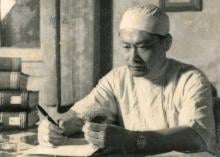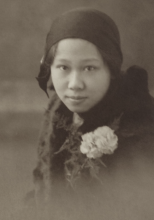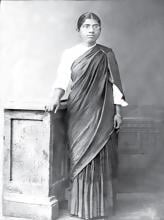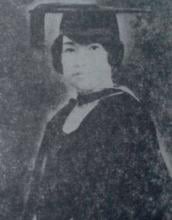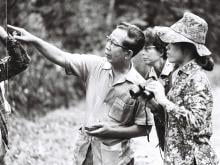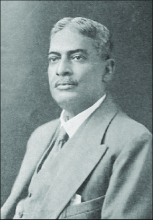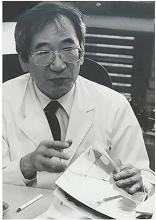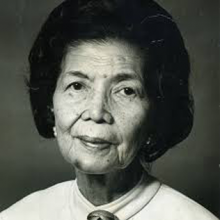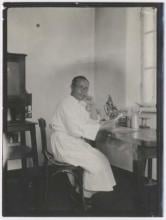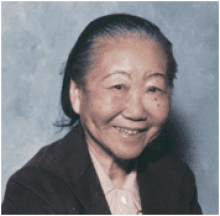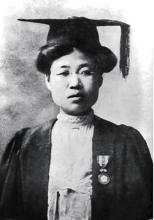Medicine
News

06 Jan 2009
Waseda University was the first private university to be selected by Japan's Ministry of Education, Culture, Sports, Science and Technology (MEXT) for the "Super Centre of Excellence" program. This is a review article for the program which ends in 2009.

04 Jan 2009
The Sports Control Council (LEKAS) of the Royal Malaysian Navy (RMN) has recently selected University Putra Malaysia’s Sports Academy as their official consultant on physical and psychology for their athletes.

04 Jan 2009
Summaries of newsworthy papers include Arrestin’ insulin resistance and New mechanism for genetic hair loss

02 Jan 2009
Summaries of newsworthy papers include Nature goes 3D, How Dark is Your Sky?, Evolution gems, Trapping and transport on a tiny scale, Cell-cycle restriction helps leukaemia stem cells keep going, Squeezed to the limit, Hijacked pathway contributes to cancer spread and power of reputation

27 Dec 2008
A unique model may describe the genetic switch that controls whether a T cell becomes a helper or a killer

27 Dec 2008
New work by researchers from RIKEN in Japan has demonstrated the dynamic process of controlling stress responses in plants. To survive, plants must react quickly to environmental hazards such as drought, cold and salt.

27 Dec 2008
Japanese researchers have identified a molecular mechanism by which bacteria found in hot springs can survive hard times. Interestingly, about half the genes involved are similar to those found in humans, but the key regulator gene is not.

21 Dec 2008
Summaries of newsworthy papers include Breaking through the barrier, Clearing plaques in blood vessels in Alzheimer’s disease, Agriculture could increase the release of carbon dioxide from rivers, Prions and smell, Rotoviruses stick to sugars, Tropical volcanic eruptions drive cooling in the tropics, The twisted history of snail shells

19 Dec 2008
Genes known as pubs have a negative effect on a plant’s immune system

19 Dec 2008
A new type of biological camera can trace several different molecules at once in a live animal

17 Dec 2008
Summaries of newsworthy papers include An engine for social change, Taking the rough with the smooth and Cancer stem cells leave their mark

17 Dec 2008
The person who did more than any other to build the world's newest and most powerful particle accelerator is named as Nature's newsmaker of 2008 and Super-resolution fluorescence microscopy has revolutionized the field of molecular and cell biology.

17 Dec 2008
In Nature China this week - Genetic heritage studies provide an insight into which Chinese individual is more likely to inherit Leber's disease

14 Dec 2008
Summaries of newsworthy papers: Neuroscience: Loud and clear, Lullaby learning, Neuronal function implicated in obesity risk, Live, fast, die old, A rotating surface shell on Mars, Avoiding overreaction and Vaccine mystery solved

12 Dec 2008
A color-shifting fluorescent protein allows researchers to observe immune cell migration that occurs in living animals

12 Dec 2008
Sandra Blakeslee, a science writer for The New York Times who specializes in the brain sciences, recently interviewed Atsushi Iriki of the RIKEN Brain Science Institute (BSI), Wako, Japan.

12 Dec 2008
The meeting, titled ‘‘Toward Synthesis of Cells—Reconstruction and Design of Cellular Functions,’’ brought together experts with diverse backgrounds to discuss ways eventually realize the synthesis of molecules, cells and organs.

10 Dec 2008
Researchers in China have shed fresh light on the signalling pathways that regulate energy balance

10 Dec 2008
Water vapour in ‘hot-Jupiter’ atmosphere?, Heating far-off oceans, The stage is set for another food crisis, Antibody therapy helps SIV-infected monkeys, Changing its spots, Mirror image molecules made with ease, Melanoma mutation, Solid-state storage device for single photons and Bacterial clean-up job

07 Dec 2008
The growing demand for cognitive enhancement within a healthy population requires a response, say leading figures in neuroscience, ethics and regulation. Their arguments are stimulated by the previously documented off-label use of such drugs by students and professors.

07 Dec 2008
Meteorite impacts may have helped spawn life on Earth, Melatonin and risk of type 2 diabetes, Cone starvation in retinitis pigmentosa, Seeing cancer specifics, New inherited factors influencing blood lipid levels, Tropical nitrogen fixation and Blood stem cells require editing

05 Dec 2008
Human granulocytic anaplasmosis has been identified in China for the
first time, and the disease may transmit from human to human

05 Dec 2008
Visual information from both eyes finally comes together when it is transmitted to the primary visual cortex. Transport of the Otx2 protein from the eye to the brain may initiate visual cortex plasticity

05 Dec 2008
Eliminating signaling molecules from tissue culture results in the generation of hypothalamic neurons from embryonic stem cells

05 Dec 2008
Tracking and halting the making of new neurons shows that continued neurogenesis is needed for spatial memory

03 Dec 2008
Summaries of newsworthy papers include Into the clouds, Tycho’s supernova classified, Education and well-being, Cancer stem cells and melanoma, Arctic freezing triggers methane burst, Video captures stem cell niche, On–off switch for a superconductor, Core fold in animal egg coats and Mechanism for a stress-free, low-calorie, long life

02 Dec 2008
A new e-learning course on Food Security Policies is available free of charge from the Food and Agriculture Organization of the United Nations. It is part of a series of food security e-learning courses and resources for trainers.

02 Dec 2008
IDRC and partner organizations will convene policy-makers, researchers, grassroots organizations and journalists from Canada and across the globe at the International Ecohealth Forum 2008 in Mérida, Mexico, December 1-5.

30 Nov 2008
Summaries of newsworthy papers include Return of North Atlantic deep convection, Family ‘friendly’ bacteria, Lessons from New Orleans, Reviving exhausted immune cells, Unbreak my heart, Molecular arms race, Snowball Earth or open oceans? and Sexual cycle of a fungus

28 Nov 2008
A method for deriving complex neuronal tissues from embryonic stem cells could yield major benefits for clinical research and the development of new therapeutics
Researchers
Sorry, no researchers coming up for this topic.
- « first
- ‹ previous
- 1
- 2
- 3
- 4
Giants in history
Vietnamese surgeon Tôn Thất Tùng (10 May 1912 – 7 May 1982) developed a pioneering technique that reduced the risks and mortality rate of liver operations.
Michiaki Takahashi (17 February 1928 – 16 December 2013) was a Japanese virologist who developed the first chickenpox vaccine.
Irene Ayako Uchida’s (8 April 1917 – 30 July 2013) strides to understand genetic diseases such as Down syndrome paved the way for early screening of chromosomal abnormalities in foetuses.
Baron Kitasato Shibasaburo (29 January 1856 – 13 June 1931) was a Japanese physician and bacteriologist whose work led to a new understanding of preventing and treating tetanus, diphtheria and anthrax.
Maggie Lim (5 January 1913 – November 1995) was a Singaporean physician who promoted family planning and expanded the access to clinics to improve the quality of life for mothers and children in Singapore’s early days.
By isolating soil microorganisms and studying the compounds they produce, Satoshi Omura (born 1935) discovered almost 500 organic compounds with unique properties that were produced by these microorganisms, including many new antibiotics.
The founder of the Adyar Cancer Institute in India, Muthulakshmi Reddy (30 July 1886 – 22 July 1968), fought to uplift women and girls from impoverished situations.
Chinese-American virologist and molecular biologist Flossie Wong-Staal (27 August 1946 – 8 July 2020) was the first scientist to clone HIV and determine the function of its genes.
Maharani Chakravorty (1937 – 2015) was one of India’s earliest molecular biologists whose research paved the way for advances in the treatment of bacterial and viral infections.
Archana Sharma (16 February 1932 - 14 January 2008) conducted research into plant and human genetics that expanded the understanding of both botany and human health. In relation to botany, she uncovered the means by which asexually-reproducing plants evolve into new species.
The first Thai woman to receive a degree in medicine, Margaret Lin Xavier (29 May 1898 – 6 December 1932), is best remembered for her compassion towards her less privileged patients.
In 1915, pathologist Katsusaburo Yamagiwa and his research assistant Koichi Ichikawa became the first to prove that chronic exposure to chemicals can cause cancer.
In 1915, Koichi Ichikawa along with pathologist Katsusaburo Yamagiwa became the first to prove that chronic exposure to chemicals can cause cancer.
Husband and wife team, Kimishige (3 December 1925 – 6 July 2018) and Teruko Ishizaka (28 September 1926 – 4 June 2019) discovered the antibody class Immunoglobulin E (IgE) that triggers allergic reactions. They also discovered that IgE antibodies attach to white blood cells, known as mast cells, releasing histamine, which causes allergic reactions.
Husband and wife team, Kimishige (3 December 1925 – 6 July 2018) and Teruko Ishizaka (28 September 1926 – 4 June 2019) discovered the antibody class Immunoglobulin E (IgE) that triggers allergic reactions. They also discovered that IgE antibodies attach to white blood cells, known as mast cells, releasing histamine, which causes allergic reactions.
Japanese chemist Takamine Jokichi (3 November 1854 – 22 July 1922) founded the Tokyo Artificial Fertilizer Company, where he isolated a starch-digesting enzyme (named takadiastase) from the fungus Aspergillus oryzae.
Ground-breaking cancer researcher Kamal Jayasing Ranadive (8 November 1917 – 11 April 2001) advanced the understanding of the causes of leukaemia, breast cancer and oesophageal cancer through the use of animal models. She was also among the first to recognise how susceptibility to cancer is linked to tumour-causing interactions between hormones and viruses.
The research of Filipino pharmaceutical chemist Luz Oliveros-Belardo (3 November 1906 – 12 December 1999) focussed on essential oils and other chemicals derived from native Philippine plants.
Thai physician and conservationist Boonsong Lekagul (1907 – 1992) made major contributions to the preservation of his country’s wildlife.
Indian scientist and physician Upendranath Brahmachari (19 December 1873–6 February 1946) is best known for creating a drug called Urea Stibamine, used to safely and reliably treat visceral leishmaniasis (or Kala-azar), a severe infection caused by the Leishmania parasite.
Filipino chemist and pharmacist Manuel A. Zamora (29 March 1870 – 9 July 1929) is best remembered for his discovery of the tiki-tiki formula to combat beriberi, a disease caused by Vitamin B1 deficiency.
Korean parasitologist Seung-Yull Cho (16 November 1943 – 27 January 2019) is remembered largely for his pioneering works to control infections caused by helminthic parasites and his contribution to journal publishing.
Fe Villanueva del Mundo (27 November 1911 – 6 August 2011) was a Filipina paediatrician who founded the Philippines’ first paediatric hospital.
After witnessing death and suffering as a youth in his home village during World War II, Nguyễn Tài Thu (6 April 1931 – 14 February 2021) set his sights on alleviating pain by becoming a doctor. After studying Traditional Chinese Medicine in China in the 1950s, Thu returned to Vietnam to serve in military hospitals. Eventually, he became the country’s foremost practitioner of acupuncture, a technique he first learned by inserting needles into himself.
Minoru Shirota (April 23, 1899 – March 10, 1982) was a Japanese microbiologist who invented the popular fermented drink Yakult.
Wu Lien-teh (10 March 1879 – 21 January 1960) was a Malaysian-born doctor who invented a mask that effectively suppressed disease transmission. Winning the prestigious Queen’s Scholarship enabled Wu to become the first Chinese student to study medicine at the University of Cambridge.
David T. Wong (born 1936) is a Hong Kong-born American neuroscientist who is best known for discovering the antidepressant drug fluoxetine, better known as Prozac.
Indian organic chemist Asima Chatterjee (1917 to 2006) studied the medicinal properties of plant products, especially compounds known as vinca alkaloids.
Chika Kuroda (24 March 1884 – 8 November 1968) was a Japanese chemist whose research focussed on the structures of natural pigments.
Umetaro Suzuki (7 April 1874 – 20 September 1943) was a Japanese scientist best remembered for his research on beriberi, a disease caused by vitamin B1 deficiency, characterized by limb stiffness, paralysis and pain.
Salimuzzaman Siddiqui (19 October 1897 – 14 April 1994) was an artist and chemist from Pakistan whose research focused on natural products from plants.
Barry Paw (29 August 1962 – 28 December 2017) was a biologist and oncologist who discovered several novel genes and their functions in red blood cells.
Syed Qasim Mehdi (13 February 1941 – 28 September 2016) was a Pakistani molecular biologist who was a founding member of the Human Genome Diversity Project (HGDP), which assessed human diversity by studying human migration, mutation rates, relationships between different populations, genes involved in height and selective pressure.
Tsai-Fan Yu (1911 – 2 March 2007) was a Chinese-American physician and researcher who was the first female full professor at Mount Sinai School of Medicine. She discovered that gout, a condition characterized by the painful inflammation of joints, was caused by elevated levels of uric acid in the bloodstream.
Min Chueh Chang (10 October 1908 – 5 June 1991) was a Chinese-American biologist who studied fertilization in mammalian reproduction.
A Japanese surgeon, Tetsuzo Akutsu (20 August 1922 – 9 August 2007) built the first artificial heart capable of keeping an animal alive.
Ogino Ginko (3 March 1851 – 23 June 1913) was the first registered female doctor to practise modern medicine in Japan.
Esther Park (1877-1910), born Kim Jeom-dong, was the first female Korean physician to practise modern medicine in Korea and trained the first generation of Korean female doctors.


